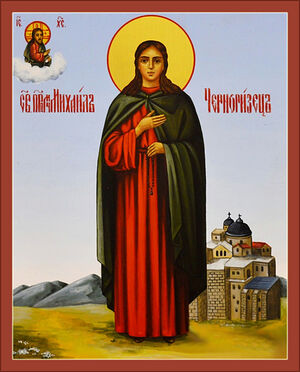 The Venerable Michael lived in the ninth century, and was from the city of Edessa in Mesopotamia, the son of Christian parents. After their death he distributed his inheritance to the poor, then went to Jerusalem to venerate the Holy Places. The Holy Land at that time was under Moslem rule.
The Venerable Michael lived in the ninth century, and was from the city of Edessa in Mesopotamia, the son of Christian parents. After their death he distributed his inheritance to the poor, then went to Jerusalem to venerate the Holy Places. The Holy Land at that time was under Moslem rule.
Michael remained in Palestine and settled in the Lavra of Saint Savva, where he became the disciple of his relative, Saint Theodore of Edessa (July 9), who spent his time both in the monastery and living as an anchorite in the Judean desert. Saint Theodore accepted him and tonsured him right away. The two made baskets of reeds together in order to support themselves. Saint Michael would take the baskets to the marketplace in Jerusalem in order to sell them.
One day while at the marketplace, the eunuch of the Muslim Queen Seida, seeing that the baskets were both fine and well-made, took him along to the Queen, who was visiting the city with her husband King al-Ma’mun (813-833). The handsome monk aroused the desire of the Queen, who tried to lead him into the sin of adultery, but he did not accept her suggestions. The enraged Seida told her husband to have the monk beaten with rods because he had insulted her, and accused him of being an enemy of Islam.
There was a debate about which faith is the true one, Christianity or Islam, and the king said, “Do as I tell you, and confess that Mohammed is a prophet and an apostle of Christ, then I will adopt you as my son.” Saint Michael said, “Mohammad is neither an apostle nor a prophet, but a deceiver and the forerunner of the antichrist. Either send me back to my Elder at the monastery, or be baptized into our Christian faith and reign forever in the heavens, or send me to Christ through martyrdom.”
The king gave the Saint a cup with deadly poison to drink. Saint Michael made the Sign of the Cross over the cup, and he drank it, but he remained unharmed, according to the promise of the Lord (Mark16:18). After this the king ordered that he be decapitated. The monks of the Lavra of Saint Savva wanted to take the Saint’s relics to their Lavra, but the Christians of Jerusalem would not permit this. They said that since he was martyred in Jerusalem, his relics ought to remain there.The monks of the Lavra disagreed with them, saying that he was nurtured in the Lavra and so he should be buried there. There was such a heated argument that the king decided that the relics would go to the Lavra.
On the same day that Saint Michael was put to death, the Lord revealed this to Saint Theodore. After informing the brethren, he sent some monks to bring the relics to the Lavra. As the relics were carried to the Lavra, there was a pillar of fire from Heaven accompanying the relics, and it remained until they reached the Lavra. Saint Theodore and the monks came out to meet the procession with lit candles, and singing hymns. The holy relics were buried with the other holy Fathers who had endured martyrdom. Many miracles took place before the relics of Saint Michael, as a sign that he had found favor with God.
At the beginning of the twelfth century the relics of Saint Michael were seen by Daniel, the Igoumen of the Kiev Caves Monastery, while on pilgrimage to the Holy Land.
Saint Michael is commemorated twice during the year: on May 23 (his repose) and July 29 (the transfer of his relics).
Troparion — Tone 1
The image of God was truly preserved in you, O Father, / for you took up the Cross and followed Christ. / By so doing you taught us to disregard the flesh for it passes away / but to care instead for the soul, since it is immortal. / Therefore your spirit, venerable Michael, rejoices with the angels.
